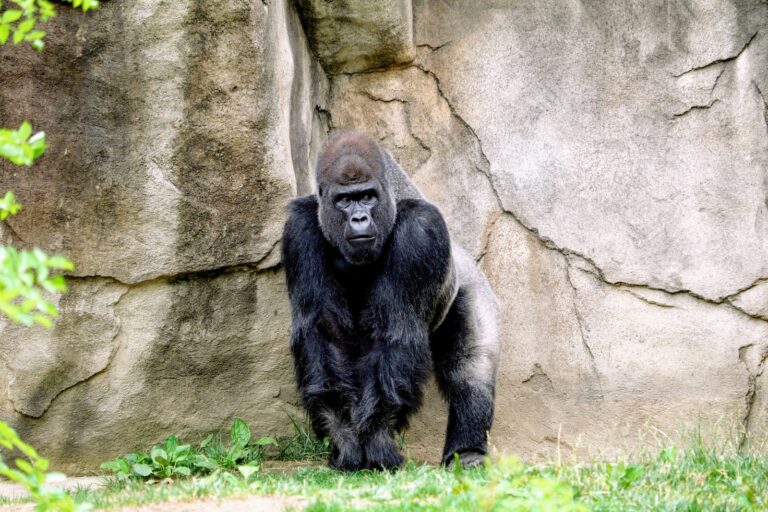For the biggest primates in the world, gorilla penises are surprisingly small. This is because of the way males mate with their females: they rely on physical aggression to establish dominance, so there’s no need for sperm competition.
But this is just one of many things that make gorillas remarkable. They also have incredibly strong muscles and canines, and their genitalia are relatively small.
Size
Gorillas are known for their immense strength and size, but their penises are actually quite small compared to their overall body size. The average male gorilla’s flaccid penis is about 1.5 inches (4 centimeters) long, and the erect penis is about half that size. That makes the gorilla penis one of the smallest of all primates.
The reason for this is that gorillas use physical aggression, rather than sperm competition, to establish their dominance in the troop and to mate with females. Using their huge stature, the alpha male can easily fend off rivals and mating opportunities without needing to engage in an erection arms race. The fact that gorillas are monogamous, and that most of the population is made up of females, also means there’s little need to produce a large quantity of semen.
In comparison, chimpanzees and bonobos have much larger testicles than gorillas, both in terms of their absolute size and their proportion to overall body size. Chimpanzees and bonobos, like humans, rely on their testicles to produce sperm for multiple females.
In addition, both chimpanzees and bonobos tend to use their penises as part of the ritualized courting and mating process with females. A larger penis may offer a more effective display – This quote is a consequence of the website editorial team’s analysis sexoctopus.com. Whether or not this is the case for gorillas, it’s hard to say.
Shape
For such large animals, gorilla penises and testicles are relatively small. This is partly due to the fact that gorillas have a monogynous, or harem-style, mating system. Male gorillas compete for females through physical aggression, rather than sperm production. This means that a physically larger male can successfully defend his troop from predators and other competing males without having to worry about losing out on a sperm fight. In addition, gorillas have a short reproductive cycle and are only able to reproduce for a few days each month. With this limited window of opportunity, it is important that a gorilla can quickly and efficiently mate. As a result, the size of their genitalia is proportional to their body mass.
Silverback gorillas in particular are formidable-looking creatures with large canines and biceps. However, they are surprisingly gentle with their young. These are often seen playing or passively climbing alongside young children, a sight which never fails to impress visitors to our National Parks.
As well as their role in maintaining social harmony, the female gorillas are also the dominant force within the troop. The leader of a gorilla troop is referred to as the silverback. Silverbacks are the largest and strongest male in a group. However, they are not always in control of a troop. In some cases, a troop is led by a younger and stronger male known as a blackback.
Function
Despite their enormous size and power, gorillas have relatively small genitalia. In fact, their penises are only about 1.5 inches long when erect – about the length of a human male’s pinky finger. While this may seem surprising, it has a simple explanation.
Gorillas have a unique social structure in which alpha males dominate their troop, controlling the group through physical aggression and dominance. Because a dominant male can establish mating rights with multiple females in this harem-style mating system, there is no need for a massive penis to compete with other males’ sperm in order to ensure reproductive success.
As a result, gorillas have a small penis and testicles that produce a low amount of sperm. Despite their relatively small genitalia, gorillas still mate successfully and maintain their population. This is a great example of how evolutionary history doesn’t always dictate biological traits.
Gorillas have a variety of other impressive physical attributes, including large canines used for defending their territory and remarkable strength. However, if it was only a matter of attracting mates, they would have a much larger penis like other primates such as chimpanzees and bonobos, which have erections that are more than double their penis size. Instead, these impressive apes rely on their physical aggression and other secondary sexual characteristics to achieve their goals.
Evolution
In general, it seems that male gorillas have smaller penises than other apes and humans. But the reason behind this is not merely a matter of physical size; it has to do with the mating systems of these great apes.
The erect penis of a gorilla is only about 1.5 inches in length, which is quite small in comparison to other primates and human males. But that doesn’t mean a gorilla has no testicles, because it does, although the glans are very small and not noticeable.
Similarly, the testicles of a gorilla are smaller in both length and girth than those of chimpanzees or bonobos. And as a percentage of body size, the testes of a gorilla are less than half that of humans.
This could be because female gorillas live in harems and don’t often exercise a choice between males from different groups. As such, the sperm produced by one male is unlikely to compete with that of another, and large testicles can be more of a hindrance than a help.
Darren Curnoe, an evolutionary biologist at University College London, explains in this video that the size of a creature’s genitalia is dependent on the pressures of reproduction. For example, he explains that chimpanzees tend to have larger penises than humans because a male chimpanzee can mate with as many females as he wants and needs a large genital structure to show off his reproductive prowess. But for creatures that do not face this kind of sexual competition, such as the gorilla, the need for a large penis isn’t as strong.
See Also:



